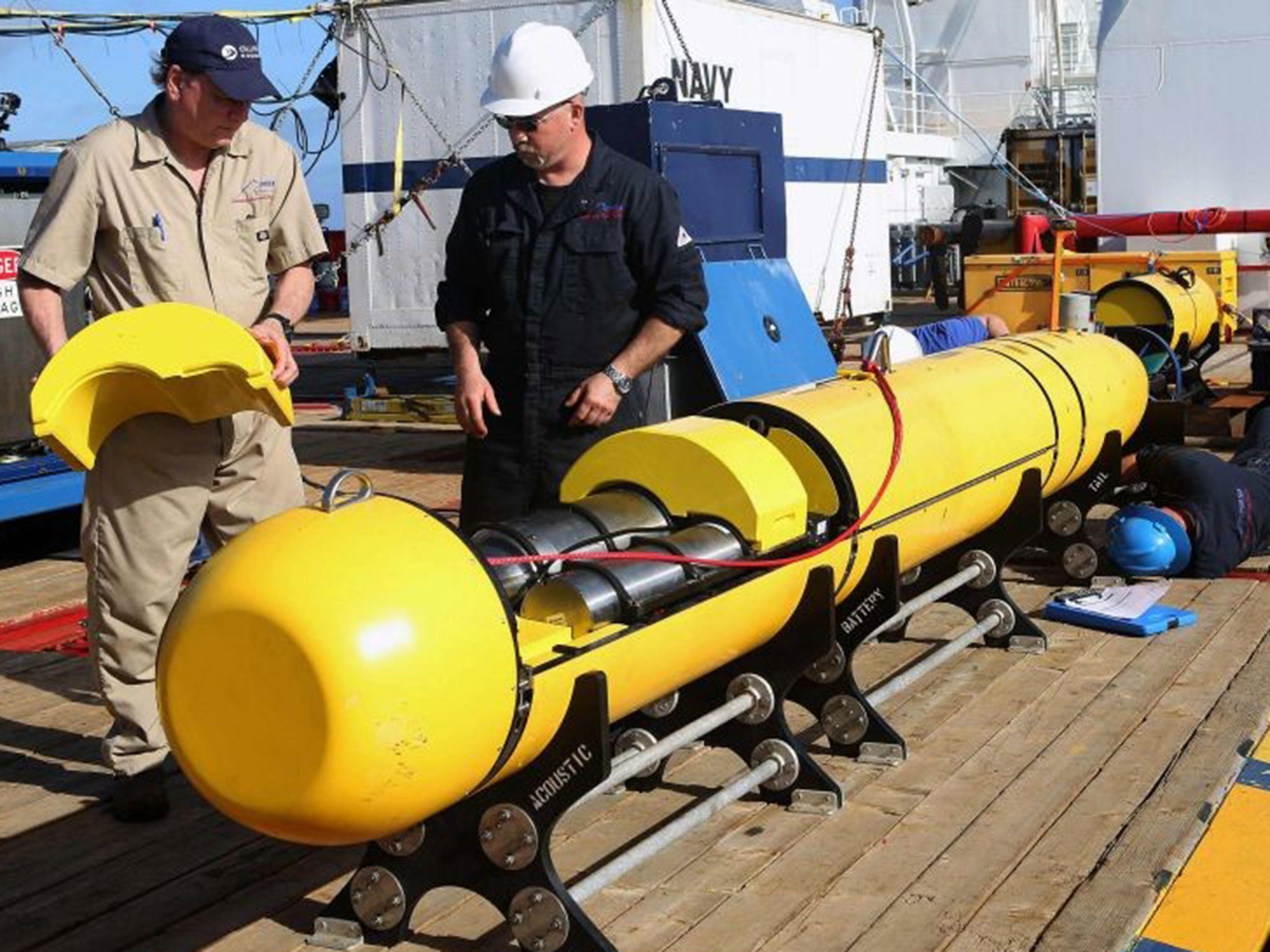Missing Malaysia Airlines flight MH370: First underwater mission fails as nothing is found and ocean proves too deep for submarine
After only six hours of its planned 16-hour mission on the sea bed, the Bluefin 21 exceeded its maximum depth limit of 4,500 metres

Your support helps us to tell the story
From reproductive rights to climate change to Big Tech, The Independent is on the ground when the story is developing. Whether it's investigating the financials of Elon Musk's pro-Trump PAC or producing our latest documentary, 'The A Word', which shines a light on the American women fighting for reproductive rights, we know how important it is to parse out the facts from the messaging.
At such a critical moment in US history, we need reporters on the ground. Your donation allows us to keep sending journalists to speak to both sides of the story.
The Independent is trusted by Americans across the entire political spectrum. And unlike many other quality news outlets, we choose not to lock Americans out of our reporting and analysis with paywalls. We believe quality journalism should be available to everyone, paid for by those who can afford it.
Your support makes all the difference.The first underwater attempt to locate wreckage from the missing Malaysia Airlines flight MH370 has ended in disappointment after the search area proved too deep for the submersible Bluefin 21 vehicle.
Just six hours into an initial planned 16-hour mission, the seabed dropped beyond the sub's maximum depth limit of 4,500 metres (15,000 feet).
What little information was gained from the sea bed has now been analysed but, according to officials, has thrown up no items of interest.
The authorities leading the search had described the Bluefin 21's efforts as their best hope in finding the Boeing 777's "black box" flight recorders, from which no signal has been detected for a full week.
Search crews had previously warned that the ocean's depth would stretch the unmanned submersible to its very limit. The Bluefin 21 has a built-in safety feature which forces it to return to the surface once its limit is exceeded.
Weather permitting, the sub will embark on a second mission later today, search organisers said. It will be moved away from the outer edges of the designated search area, where it is believed the deeper water is located.
Vehicles with a deeper range have been requested by the search organisers, but until one arrives Bluefin 21 will remain the best and only option.
Meanwhile, officials were still waiting for the results of analysis on an oil slick found about 5.5km (3.4 miles) from the area where the last underwater sounds were detected, said Angus Houston, the head of a joint agency coordinating the search off Australia's west coast.
The process will take several days, and while Houston said the oil does not appear to be from any of the ships in the area, he cautioned against jumping to conclusions about its source.
Australian Prime Minister Tony Abbott raised hopes last week when he said authorities were "very confident" the four strong underwater signals that were detected were from the black boxes on MH370, which disappeared on 8 March during a flight from Kuala Lumpur, Malaysia, to Beijing with 239 people on board.
But Houston warned that while the signals are a promising lead, the public needs to be realistic about the challenges facing search crews in the extremely remote, deep patch of ocean - an area he called "new to man".
"I would caution you against raising hopes that the deployment of the autonomous underwater vehicle will result in the detection of the aircraft wreckage. It may not," Houston said. "However, this is the best lead we have, and it must be pursued vigorously. Again, I emphasize that this will be a slow and painstaking process."
Houston, a retired Australian chief air marshal, called the mission "one of the largest search and rescue, search and recovery operations that I've seen in my lifetime".
Stefan Williams, a professor of marine robotics at the University of Sydney, explained that while the "pings" detected by the Australian navy's Ocean Shield vessel were recorded at a specific depth, the search crews knew relatively little around the surrounding ocean floor.
"Maybe some areas where they are doing the survey are a little bit deeper than they are expecting," he said. "They may not have very reliable prior data for the area, so they have a general idea. But there may be some variability on the sea floor that they also can't see from the surface.
"What they're going to have to be looking for is contrast between hard objects, like bits of a fuselage, and that silty bottom," Williams added. "With the types of sonars they are using, if stuff is sitting up on top of the silt, say a wing was there, you could likely see that ... but small items might sink down into the silt and be covered and then it's going to be a lot more challenging."
Around 11 ships and as many planes join the visual search of the surface of the Indian Ocean on Tuesday, scouring an area over 62,000 square km (24,000 square miles), around 2,200 km (1,400 miles) northwest of Perth.
It is expected to be one of the final attempts to find floating debris, with more than a month of searches has so far not turning up a single item linked to the plane. Houston yesterday described the chances of now finding any wreckage on the surface as "greatly diminished".
Join our commenting forum
Join thought-provoking conversations, follow other Independent readers and see their replies
Comments